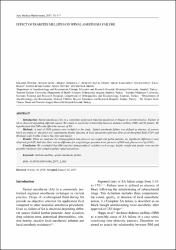Effect of Diabetes Mellitus on Spinal Anesthesia Failure

View/
Date
2017Author
Öztürk, İbrahimKılıç, Bülent
Demiroğlu, Murat
Alptekin, Hüseyin Alp
Yazıcıoğlu, Dilek
Oğuz, Eylem
Baran, İlkay
Aydın, Gözde Bumin
Öztürk, Selen
Orhon, Zeynep Nur
Metadata
Show full item recordAbstract
Introduction: Spinal anesthesia (SA) is a commonly performed regional anesthesia technique in current practice. Failure of SA is observed depending different causes. We aimed to search the relationship between diabetes mellitus (DM) and SA failure. We hypothesized that DM could affect the success of SA. Methods: A total of 1032 patients were included to the study. Spinal anesthesia failure was defined as absence of sensory block according to ‘pin-prick test’ examination despite injection of local anesthetics after free flow of cerebrospinal fluid (CSF) and Bromage scale 4 (able to move hip, knee and ankle). Results: When we analysed the demographical data between successful and failed patients, no significant differences were observed (p>0.05) And also there was no difference for surgical type, puncture level, presence of DM and glucose level (p>0.05). Conclusion: We concluded that DM and also demographical variables such as age, height, weight and gender were not the possible risk factors for complete failure spinal anesthesia.
Volume
2017Issue
3Collections
The following license files are associated with this item:

















